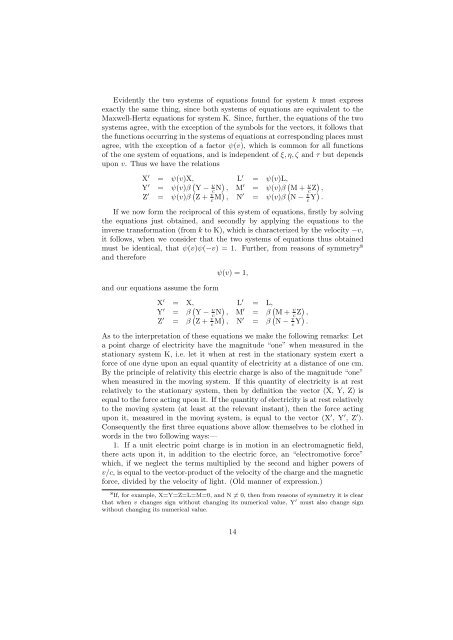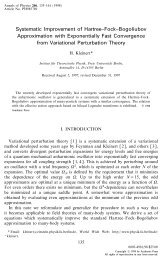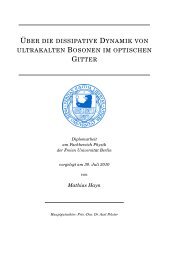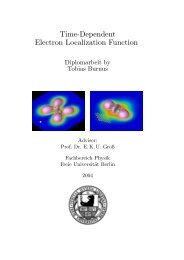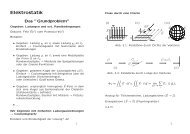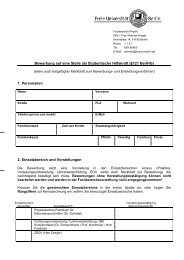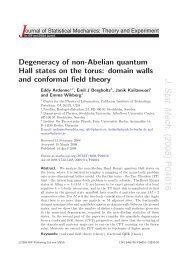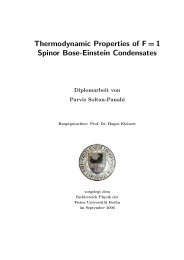Einstein's 1905 paper
Einstein's 1905 paper
Einstein's 1905 paper
You also want an ePaper? Increase the reach of your titles
YUMPU automatically turns print PDFs into web optimized ePapers that Google loves.
Evidently the two systems of equations found for system k must express<br />
exactly the same thing, since both systems of equations are equivalent to the<br />
Maxwell-Hertz equations for system K. Since, further, the equations of the two<br />
systems agree, with the exception of the symbols for the vectors, it follows that<br />
the functions occurring in the systems of equations at corresponding places must<br />
agree, with the exception of a factor ψ(v), which is common for all functions<br />
of the one system of equations, and is independent of ξ, η, ζ and τ but depends<br />
upon v. Thus we have the relations<br />
X ′ = ψ(v)X, L ′ = ψ(v)L,<br />
Y ′ = ψ(v)β ( Y − v c N) , M ′ = ψ(v)β ( M + v c Z) ,<br />
Z ′ = ψ(v)β ( Z + v c M) , N ′ = ψ(v)β ( N − v c Y) .<br />
If we now form the reciprocal of this system of equations, firstly by solving<br />
the equations just obtained, and secondly by applying the equations to the<br />
inverse transformation (from k to K), which is characterized by the velocity −v,<br />
it follows, when we consider that the two systems of equations thus obtained<br />
must be identical, that ψ(v)ψ(−v) = 1. Further, from reasons of symmetry 8<br />
and therefore<br />
and our equations assume the form<br />
ψ(v) = 1,<br />
X ′ = X, L ′ = L,<br />
Y ′ = β ( Y − v c N) , M ′ = β ( M + v c Z) ,<br />
Z ′ = β ( Z + v c M) , N ′ = β ( N − v c Y) .<br />
As to the interpretation of these equations we make the following remarks: Let<br />
a point charge of electricity have the magnitude “one” when measured in the<br />
stationary system K, i.e. let it when at rest in the stationary system exert a<br />
force of one dyne upon an equal quantity of electricity at a distance of one cm.<br />
By the principle of relativity this electric charge is also of the magnitude “one”<br />
when measured in the moving system. If this quantity of electricity is at rest<br />
relatively to the stationary system, then by definition the vector (X, Y, Z) is<br />
equal to the force acting upon it. If the quantity of electricity is at rest relatively<br />
to the moving system (at least at the relevant instant), then the force acting<br />
upon it, measured in the moving system, is equal to the vector (X ′ , Y ′ , Z ′ ).<br />
Consequently the first three equations above allow themselves to be clothed in<br />
words in the two following ways:—<br />
1. If a unit electric point charge is in motion in an electromagnetic field,<br />
there acts upon it, in addition to the electric force, an “electromotive force”<br />
which, if we neglect the terms multiplied by the second and higher powers of<br />
v/c, is equal to the vector-product of the velocity of the charge and the magnetic<br />
force, divided by the velocity of light. (Old manner of expression.)<br />
8 If, for example, X=Y=Z=L=M=0, and N ≠ 0, then from reasons of symmetry it is clear<br />
that when v changes sign without changing its numerical value, Y ′ must also change sign<br />
without changing its numerical value.<br />
14


